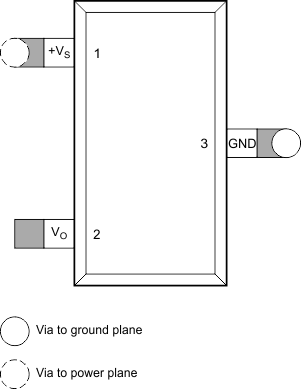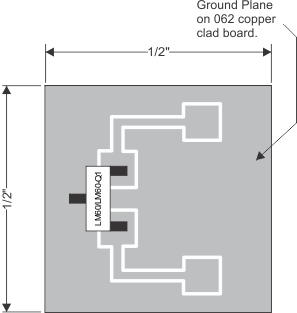ZHCSGX1F May 2004 – August 2017 LM60
PRODUCTION DATA.
11 Layout
11.1 Layout Guidelines
The LM60 can be applied easily in the same way as other integrated-circuit temperature sensors. It can be glued or cemented to a surface. The temperature that the LM60 is sensing will be within about +0.1°C of the surface temperature that the leads of th LM60 are attached to.
This presumes that the ambient air temperature is almost the same as the surface temperature. If the air temperature were much higher or lower than the surface temperature, the actual temperature of the device die would be at an intermediate temperature between the surface temperature and the air temperature.
To ensure good thermal conductivity the backside of the device die is directly attached to the GND pin. The lands and traces to the device will, of course, be part of the printed-circuit board, which is the object whose temperature is being measured. These printed-circuit board lands and traces do not cause the temperature of the device to deviate from the desired temperature.
Alternatively, the device can be mounted inside a sealed-end metal tube, and can then be dipped into a bath or screwed into a threaded hole in a tank. As with any IC, the device and accompanying wiring and circuits must be kept insulated and dry to avoid leakage and corrosion. Specifically when the device operates at cold temperatures where condensation can occur. Printed-circuit coatings and varnishes such as a conformal coating and epoxy paints or dips are often used to ensure that moisture cannot corrode the device or connections.
11.2 Layout Example

11.3 Thermal Considerations
The thermal resistance junction to ambient (RθJA) is the parameter used to calculate the rise of a device junction temperature due to the device power dissipation. Use Equation 4 to calculate the rise in the die temperature of the device.
where
- IQ is the quiescent current
- IL is the load current on the output
Table 2 summarizes the rise in die temperature of the LM60 without any loading, and the thermal resistance for different conditions. The values in Table 2 were actually measured where as the values shown in Thermal Information where calculated using modeling methods as described in the Semiconductor and IC Package Thermal Metrics (SPRA953) application report.
Table 2. Temperature Rise of LM60 Due to Self-Heating and Thermal Resistance (RθJA)
| SOT-23(1)
NO HEAT SINK |
SOT-23(2)
SMALL HEAT FIN |
TO-92(1)
NO HEAT FIN |
TO-92(3)
SMALL HEAT FIN |
|||||
|---|---|---|---|---|---|---|---|---|
| RθJA | TJ − TA | RθJA | TJ − TA | RθJA | TJ − TA | RθJA | TJ − TA | |
| (°C/W) | (°C) | (°C/W) | (°C) | (°C/W) | (°C) | (°C/W) | (°C) | |
| Still air | 450 | 0.17 | 260 | 0.1 | 180 | 0.07 | 140 | 0.05 |
| Moving air | — | — | 180 | 0.07 | 90 | 0.034 | 70 | 0.026 |
